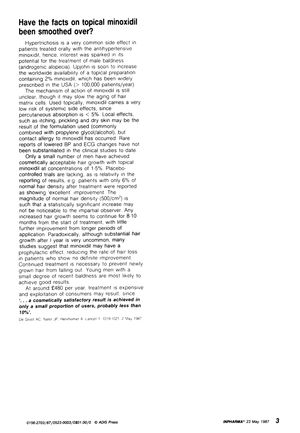Have The Facts On Topical Minoxidil Been Smoothed Over?
May 1987
in “
Inpharma (Balgowlah)
”

TLDR Topical minoxidil may slow hair loss but often doesn't lead to satisfactory hair regrowth and requires ongoing treatment.
The document discusses the use of topical minoxidil, an antihypertensive medication known to cause hypertrichosis, for the treatment of male baldness (androgenic alopecia). It has been prescribed to over 100,000 patients per year in the USA in a 2% topical preparation. The exact mechanism of action is unclear, but it may slow the aging of hair matrix cells. Topical application has a low risk of systemic side effects due to less than 5% percutaneous absorption, though local side effects like itching and dry skin may occur, sometimes due to the formulation rather than the drug itself. Clinical studies have not confirmed serious side effects such as lowered blood pressure or ECG changes. However, only a small percentage of men have achieved cosmetically acceptable hair growth with 1-5% concentrations of topical minoxidil. The document criticizes the lack of placebo-controlled trials and relative reporting of results, noting that a significant increase in hair density may not be noticeable and that hair growth tends to plateau after 8-10 months of treatment. Minoxidil may have a prophylactic effect in reducing hair loss rate, but continuous treatment is required to maintain any new hair growth. The treatment is costly at around £480 per year, and less than 10% of users achieve a satisfactory cosmetic result, raising concerns about consumer exploitation. Young men with recent onset of baldness are the most likely to see good results.
